Jiawei Liang
Explaining multimodal LLMs via intra-modal token interactions
Sep 26, 2025Abstract:Multimodal Large Language Models (MLLMs) have achieved remarkable success across diverse vision-language tasks, yet their internal decision-making mechanisms remain insufficiently understood. Existing interpretability research has primarily focused on cross-modal attribution, identifying which image regions the model attends to during output generation. However, these approaches often overlook intra-modal dependencies. In the visual modality, attributing importance to isolated image patches ignores spatial context due to limited receptive fields, resulting in fragmented and noisy explanations. In the textual modality, reliance on preceding tokens introduces spurious activations. Failing to effectively mitigate these interference compromises attribution fidelity. To address these limitations, we propose enhancing interpretability by leveraging intra-modal interaction. For the visual branch, we introduce \textit{Multi-Scale Explanation Aggregation} (MSEA), which aggregates attributions over multi-scale inputs to dynamically adjust receptive fields, producing more holistic and spatially coherent visual explanations. For the textual branch, we propose \textit{Activation Ranking Correlation} (ARC), which measures the relevance of contextual tokens to the current token via alignment of their top-$k$ prediction rankings. ARC leverages this relevance to suppress spurious activations from irrelevant contexts while preserving semantically coherent ones. Extensive experiments across state-of-the-art MLLMs and benchmark datasets demonstrate that our approach consistently outperforms existing interpretability methods, yielding more faithful and fine-grained explanations of model behavior.
Physical Adversarial Camouflage through Gradient Calibration and Regularization
Aug 07, 2025Abstract:The advancement of deep object detectors has greatly affected safety-critical fields like autonomous driving. However, physical adversarial camouflage poses a significant security risk by altering object textures to deceive detectors. Existing techniques struggle with variable physical environments, facing two main challenges: 1) inconsistent sampling point densities across distances hinder the gradient optimization from ensuring local continuity, and 2) updating texture gradients from multiple angles causes conflicts, reducing optimization stability and attack effectiveness. To address these issues, we propose a novel adversarial camouflage framework based on gradient optimization. First, we introduce a gradient calibration strategy, which ensures consistent gradient updates across distances by propagating gradients from sparsely to unsampled texture points. Additionally, we develop a gradient decorrelation method, which prioritizes and orthogonalizes gradients based on loss values, enhancing stability and effectiveness in multi-angle optimization by eliminating redundant or conflicting updates. Extensive experimental results on various detection models, angles and distances show that our method significantly exceeds the state of the art, with an average increase in attack success rate (ASR) of 13.46% across distances and 11.03% across angles. Furthermore, empirical evaluation in real-world scenarios highlights the need for more robust system design.
3D Gaussian Splatting Driven Multi-View Robust Physical Adversarial Camouflage Generation
Jul 02, 2025Abstract:Physical adversarial attack methods expose the vulnerabilities of deep neural networks and pose a significant threat to safety-critical scenarios such as autonomous driving. Camouflage-based physical attack is a more promising approach compared to the patch-based attack, offering stronger adversarial effectiveness in complex physical environments. However, most prior work relies on mesh priors of the target object and virtual environments constructed by simulators, which are time-consuming to obtain and inevitably differ from the real world. Moreover, due to the limitations of the backgrounds in training images, previous methods often fail to produce multi-view robust adversarial camouflage and tend to fall into sub-optimal solutions. Due to these reasons, prior work lacks adversarial effectiveness and robustness across diverse viewpoints and physical environments. We propose a physical attack framework based on 3D Gaussian Splatting (3DGS), named PGA, which provides rapid and precise reconstruction with few images, along with photo-realistic rendering capabilities. Our framework further enhances cross-view robustness and adversarial effectiveness by preventing mutual and self-occlusion among Gaussians and employing a min-max optimization approach that adjusts the imaging background of each viewpoint, helping the algorithm filter out non-robust adversarial features. Extensive experiments validate the effectiveness and superiority of PGA. Our code is available at:https://github.com/TRLou/PGA.
SpNeRF: Memory Efficient Sparse Volumetric Neural Rendering Accelerator for Edge Devices
May 13, 2025Abstract:Neural rendering has gained prominence for its high-quality output, which is crucial for AR/VR applications. However, its large voxel grid data size and irregular access patterns challenge real-time processing on edge devices. While previous works have focused on improving data locality, they have not adequately addressed the issue of large voxel grid sizes, which necessitate frequent off-chip memory access and substantial on-chip memory. This paper introduces SpNeRF, a software-hardware co-design solution tailored for sparse volumetric neural rendering. We first identify memory-bound rendering inefficiencies and analyze the inherent sparsity in the voxel grid data of neural rendering. To enhance efficiency, we propose novel preprocessing and online decoding steps, reducing the memory size for voxel grid. The preprocessing step employs hash mapping to support irregular data access while maintaining a minimal memory size. The online decoding step enables efficient on-chip sparse voxel grid processing, incorporating bitmap masking to mitigate PSNR loss caused by hash collisions. To further optimize performance, we design a dedicated hardware architecture supporting our sparse voxel grid processing technique. Experimental results demonstrate that SpNeRF achieves an average 21.07$\times$ reduction in memory size while maintaining comparable PSNR levels. When benchmarked against Jetson XNX, Jetson ONX, RT-NeRF.Edge and NeuRex.Edge, our design achieves speedups of 95.1$\times$, 63.5$\times$, 1.5$\times$ and 10.3$\times$, and improves energy efficiency by 625.6$\times$, 529.1$\times$, 4$\times$, and 4.4$\times$, respectively.
Efficient Backdoor Defense in Multimodal Contrastive Learning: A Token-Level Unlearning Method for Mitigating Threats
Sep 29, 2024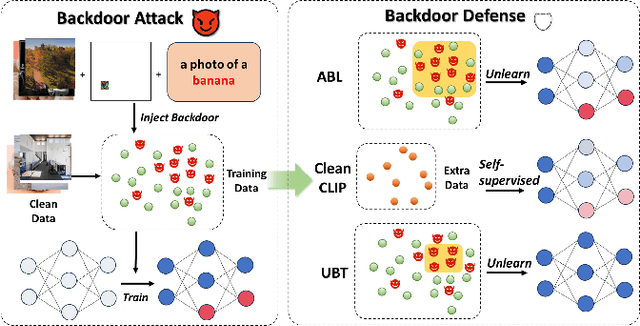
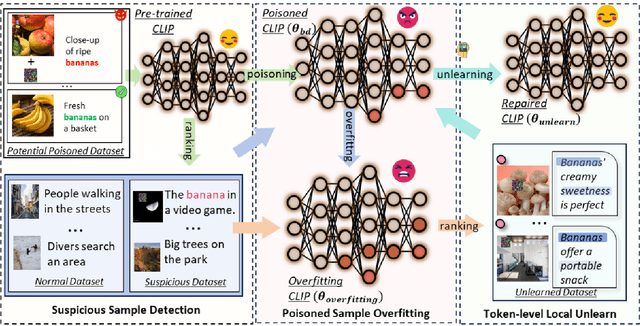

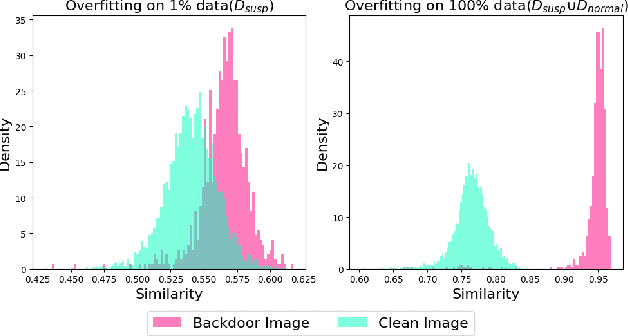
Abstract:Multimodal contrastive learning uses various data modalities to create high-quality features, but its reliance on extensive data sources on the Internet makes it vulnerable to backdoor attacks. These attacks insert malicious behaviors during training, which are activated by specific triggers during inference, posing significant security risks. Despite existing countermeasures through fine-tuning that reduce the malicious impacts of such attacks, these defenses frequently necessitate extensive training time and degrade clean accuracy. In this study, we propose an efficient defense mechanism against backdoor threats using a concept known as machine unlearning. This entails strategically creating a small set of poisoned samples to aid the model's rapid unlearning of backdoor vulnerabilities, known as Unlearn Backdoor Threats (UBT). We specifically use overfit training to improve backdoor shortcuts and accurately detect suspicious samples in the potential poisoning data set. Then, we select fewer unlearned samples from suspicious samples for rapid forgetting in order to eliminate the backdoor effect and thus improve backdoor defense efficiency. In the backdoor unlearning process, we present a novel token-based portion unlearning training regime. This technique focuses on the model's compromised elements, dissociating backdoor correlations while maintaining the model's overall integrity. Extensive experimental results show that our method effectively defends against various backdoor attack methods in the CLIP model. Compared to SoTA backdoor defense methods, UBT achieves the lowest attack success rate while maintaining a high clean accuracy of the model (attack success rate decreases by 19% compared to SOTA, while clean accuracy increases by 2.57%).
Adversarial Backdoor Defense in CLIP
Sep 24, 2024



Abstract:Multimodal contrastive pretraining, exemplified by models like CLIP, has been found to be vulnerable to backdoor attacks. While current backdoor defense methods primarily employ conventional data augmentation to create augmented samples aimed at feature alignment, these methods fail to capture the distinct features of backdoor samples, resulting in suboptimal defense performance. Observations reveal that adversarial examples and backdoor samples exhibit similarities in the feature space within the compromised models. Building on this insight, we propose Adversarial Backdoor Defense (ABD), a novel data augmentation strategy that aligns features with meticulously crafted adversarial examples. This approach effectively disrupts the backdoor association. Our experiments demonstrate that ABD provides robust defense against both traditional uni-modal and multimodal backdoor attacks targeting CLIP. Compared to the current state-of-the-art defense method, CleanCLIP, ABD reduces the attack success rate by 8.66% for BadNet, 10.52% for Blended, and 53.64% for BadCLIP, while maintaining a minimal average decrease of just 1.73% in clean accuracy.
Revisiting Backdoor Attacks against Large Vision-Language Models
Jun 27, 2024Abstract:Instruction tuning enhances large vision-language models (LVLMs) but raises security risks through potential backdoor attacks due to their openness. Previous backdoor studies focus on enclosed scenarios with consistent training and testing instructions, neglecting the practical domain gaps that could affect attack effectiveness. This paper empirically examines the generalizability of backdoor attacks during the instruction tuning of LVLMs for the first time, revealing certain limitations of most backdoor strategies in practical scenarios. We quantitatively evaluate the generalizability of six typical backdoor attacks on image caption benchmarks across multiple LVLMs, considering both visual and textual domain offsets. Our findings indicate that attack generalizability is positively correlated with the backdoor trigger's irrelevance to specific images/models and the preferential correlation of the trigger pattern. Additionally, we modify existing backdoor attacks based on the above key observations, demonstrating significant improvements in cross-domain scenario generalizability (+86% attack success rate). Notably, even without access to the instruction datasets, a multimodal instruction set can be successfully poisoned with a very low poisoning rate (0.2%), achieving an attack success rate of over 97%. This paper underscores that even simple traditional backdoor strategies pose a serious threat to LVLMs, necessitating more attention and in-depth research.
Unlearning Backdoor Threats: Enhancing Backdoor Defense in Multimodal Contrastive Learning via Local Token Unlearning
Mar 24, 2024Abstract:Multimodal contrastive learning has emerged as a powerful paradigm for building high-quality features using the complementary strengths of various data modalities. However, the open nature of such systems inadvertently increases the possibility of backdoor attacks. These attacks subtly embed malicious behaviors within the model during training, which can be activated by specific triggers in the inference phase, posing significant security risks. Despite existing countermeasures through fine-tuning that reduce the adverse impacts of such attacks, these defenses often degrade the clean accuracy and necessitate the construction of extensive clean training pairs. In this paper, we explore the possibility of a less-cost defense from the perspective of model unlearning, that is, whether the model can be made to quickly \textbf{u}nlearn \textbf{b}ackdoor \textbf{t}hreats (UBT) by constructing a small set of poisoned samples. Specifically, we strengthen the backdoor shortcuts to discover suspicious samples through overfitting training prioritized by weak similarity samples. Building on the initial identification of suspicious samples, we introduce an innovative token-based localized forgetting training regime. This technique specifically targets the poisoned aspects of the model, applying a focused effort to unlearn the backdoor associations and trying not to damage the integrity of the overall model. Experimental results show that our method not only ensures a minimal success rate for attacks, but also preserves the model's high clean accuracy.
VL-Trojan: Multimodal Instruction Backdoor Attacks against Autoregressive Visual Language Models
Feb 21, 2024


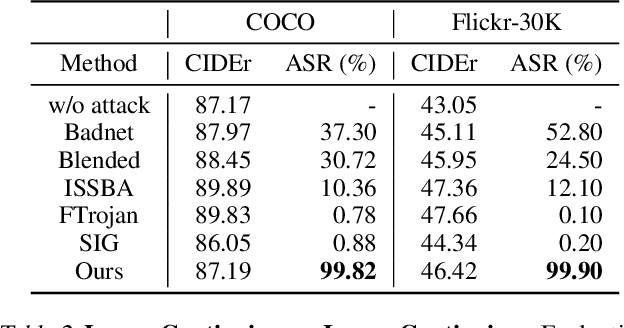
Abstract:Autoregressive Visual Language Models (VLMs) showcase impressive few-shot learning capabilities in a multimodal context. Recently, multimodal instruction tuning has been proposed to further enhance instruction-following abilities. However, we uncover the potential threat posed by backdoor attacks on autoregressive VLMs during instruction tuning. Adversaries can implant a backdoor by injecting poisoned samples with triggers embedded in instructions or images, enabling malicious manipulation of the victim model's predictions with predefined triggers. Nevertheless, the frozen visual encoder in autoregressive VLMs imposes constraints on the learning of conventional image triggers. Additionally, adversaries may encounter restrictions in accessing the parameters and architectures of the victim model. To address these challenges, we propose a multimodal instruction backdoor attack, namely VL-Trojan. Our approach facilitates image trigger learning through an isolating and clustering strategy and enhance black-box-attack efficacy via an iterative character-level text trigger generation method. Our attack successfully induces target outputs during inference, significantly surpassing baselines (+62.52\%) in ASR. Moreover, it demonstrates robustness across various model scales and few-shot in-context reasoning scenarios.
Poisoned Forgery Face: Towards Backdoor Attacks on Face Forgery Detection
Feb 18, 2024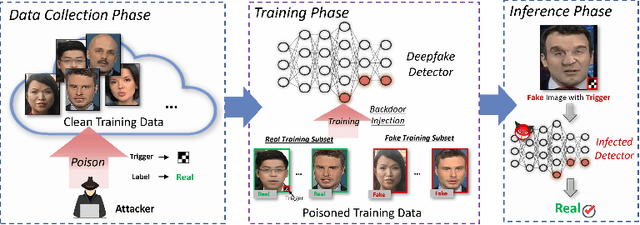
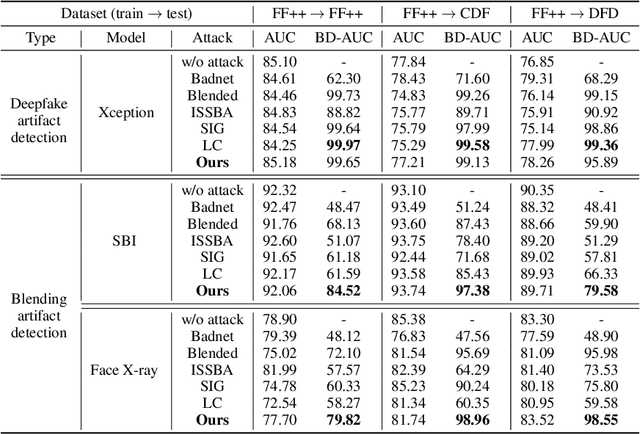

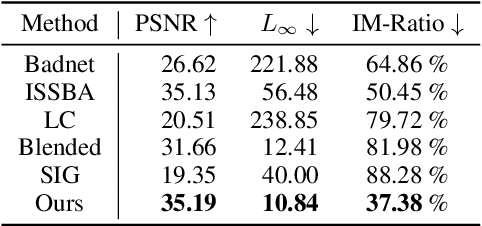
Abstract:The proliferation of face forgery techniques has raised significant concerns within society, thereby motivating the development of face forgery detection methods. These methods aim to distinguish forged faces from genuine ones and have proven effective in practical applications. However, this paper introduces a novel and previously unrecognized threat in face forgery detection scenarios caused by backdoor attack. By embedding backdoors into models and incorporating specific trigger patterns into the input, attackers can deceive detectors into producing erroneous predictions for forged faces. To achieve this goal, this paper proposes \emph{Poisoned Forgery Face} framework, which enables clean-label backdoor attacks on face forgery detectors. Our approach involves constructing a scalable trigger generator and utilizing a novel convolving process to generate translation-sensitive trigger patterns. Moreover, we employ a relative embedding method based on landmark-based regions to enhance the stealthiness of the poisoned samples. Consequently, detectors trained on our poisoned samples are embedded with backdoors. Notably, our approach surpasses SoTA backdoor baselines with a significant improvement in attack success rate (+16.39\% BD-AUC) and reduction in visibility (-12.65\% $L_\infty$). Furthermore, our attack exhibits promising performance against backdoor defenses. We anticipate that this paper will draw greater attention to the potential threats posed by backdoor attacks in face forgery detection scenarios. Our codes will be made available at \url{https://github.com/JWLiang007/PFF}
 Add to Chrome
Add to Chrome Add to Firefox
Add to Firefox Add to Edge
Add to Edge